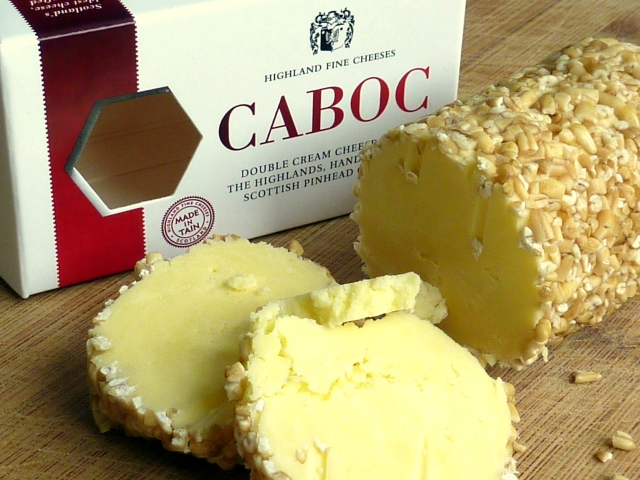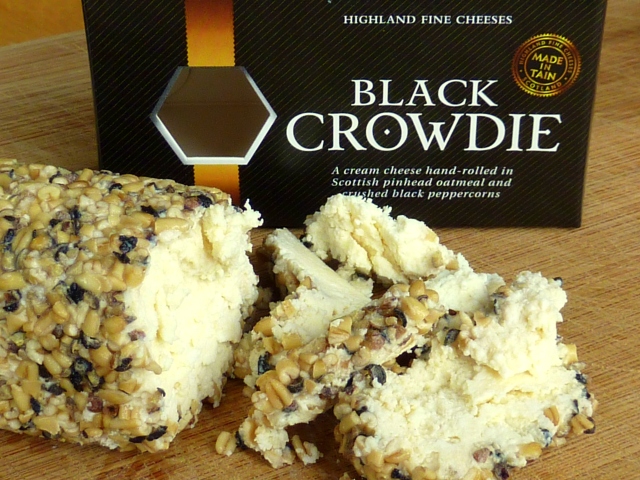Originating in the Western highlands Caboc is one of Scotlands oldest cheeses. Dating back to the 15th Century it was known as a chieftain’s cheese, due to its rich double cream ingredients and high fat content. Reputedly the recipe originates from the daughter of the chieftain MacDonald of the Isles, Mariota de Ile. At the age of 12 she was in danger from the Clan Campbell who had plans to steal her away to forcefully marry one of their and seize her lands. Escaping to Ireland and finding refuge in a nunnery she there learnt the arts of cheese making from her Irish hosts. Later returning to a more suitable marriage Mariota passed on her recipe, which still a family secret, has been past down from mother to daughter to the present day. The current descendant of the clan and owner of the recipe Susannah Stone who working from her farm in Tain makes and sells the cheese under the seal of Highland Fine Cheeses.
The caboc is make using double cream from local cows and soured using a bacterial culture without rennet the cheese is shaped into small logs rolled in toasted pinhead oatmeal. The high fat content at 67% gives the cheese a primrose yellow color and a rich smooth, buttery taste with a slight acid tang while the oatmeal adds a nutty flavour. Usually eaten within a few days of being made it will keep for up to three weeks in the fridge. It adds a rich buttery addition to Scottish oatcakes.
In contrast to caboc, crowdie was the universal cheese of the Scottish crofter and most likely Scotlands most ancient cheese, its origin perhaps stretching back into the mists of time to Viking invaders or perhaps even further to the ancient Picts. At one time made across the Highlands by crofters it formed a staple part of their diet. The cheese was commonly made after most of the cream had been skimmed off the milk, to use or make into butter, resulting in a low-fat resulting cheese that is very different from the rich creamy Caboc. The term crowdie was originally used by the Scots to describe the dishes of oatmeal and water that were such a staple of the old Scottish diet. Being so ubiquitous the name crowdie eventually became transferred to the meal itself and all kinds of commonly eaten dishes ended up with the word Crowdie added to them, an indication of how often this cheese was on the menu for ordinary crofters.
This particular variation known as Black Crowdie, or Gruth Dhu in Gaelic, is rolled in toasted oatmeal mixed with cracked black pepper giving the cheese quite a hot kick to it.
An unusual feature of Crowdie is that it is semi-cooked. The fresh unpasteurized milk was left to naturally sour beside the stove resulting in a lovely sharp, citric flavour in the cheese. The cream was skimmed off and the soured milk was then scrambled over the heat of the fire and hung up in a muslin cloth to allow the whey to separate out. Once the whey had been strained off salt and sometimes a little cream was added to the curds, making a soft, crumbly white cheese. In the traditional manner this crowdie from Highland Fine Cheeses is soured with lactic acid cultures and without the use of rennet resulting in a traditional sharp flavour.
As in the case of Caboc the survival of Crowdie is largely thanks to Susannah Stone, who has been producing these traditional Scottish cheeses since 1963. Crowdie making had declined after the Second World War with the passing of crofting traditions but Susannah Stone continued to make it at her home in the Ross-shire village of Tain. Apparently one day in 1962, after making too much and offering the surplus to a local grocer her cheese became popular enough that her crowdie became the first artisan cheese produced by family business Highland Fine Cheeses, still produced now 50 years later with the company managed by her son Rory Stone. This ancient cheese is unique to the Highland and Islands of Scotland and is apparently not made anywhere else in Europe.



where can these cheeses be purchased ?
LikeLike
Colin
Try your local deli – mine, in Derby UK, gets Caboc and Blue Murder in from time to time, so they’re clearly available to them from a wholesaler.
d.
LikeLike